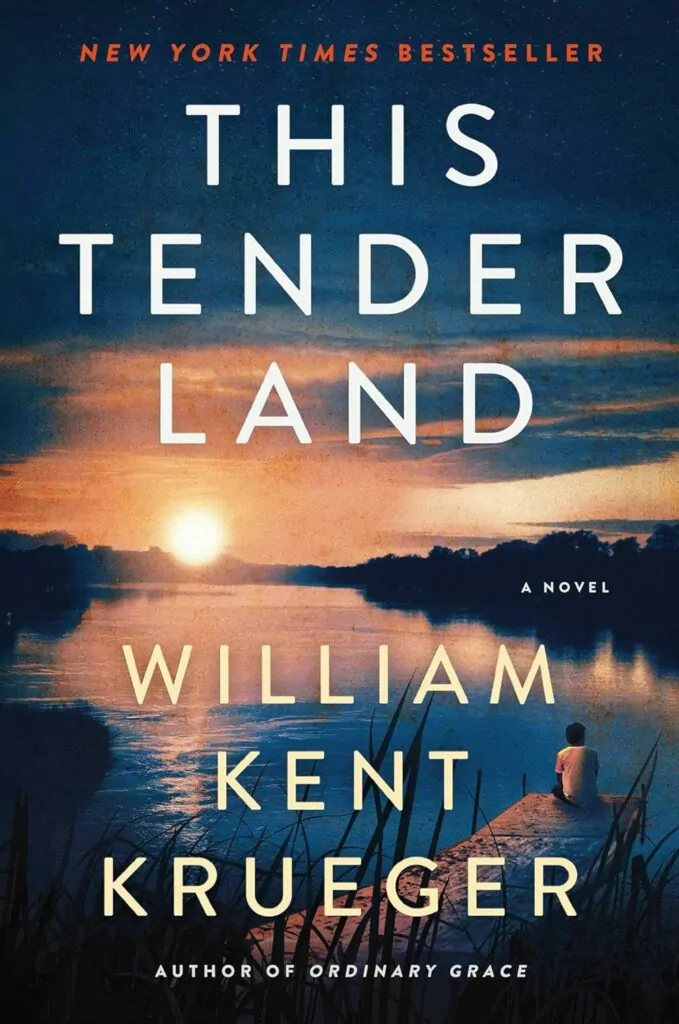“This Tender Land” by William Kent Krueger is a powerful and evocative novel set against the backdrop of the Great Depression. In this discussion, we dive into the intricate layers of a story that blends adventure, historical context, and deep emotional resonance.
We begin with an extended summary of the book, providing a comprehensive overview of the narrative. This summary sets the stage, introducing the key settings, the plight of the four orphans at the heart of the story, and their brave journey across the Midwest in search of a place to call home. It lays the foundation for understanding the novel’s context and the significant themes it explores.
Following the summary, we focus on the characters of “This Tender Land”. We delve into the lives of Odie O’Banion, his brother Albert, their friend Mose, and the young Emmy. Each character is explored in terms of their background, their role in the story, and their personal growth throughout the journey.
Next, we cover we quotes from the book, offering deep insights into the characters’ experiences and the landscape of the era.
Finally, we present a series of thought-provoking book club questions. These questions are designed to spark an engaging discussion, encouraging readers to reflect on the novel’s themes, character dynamics, historical context, and the emotional journey that Krueger so masterfully depicts.
Through this exploration, our aim is to provide a helpful guide to “This Tender Land”. Whether you’re reading this novel for personal enjoyment or as part of a book club, our insights are intended to enhance your understanding and appreciation of William Kent Krueger’s moving and memorable tale.
This Tender Land Summary
“This Tender Land” by William Kent Krueger is an evocative and heartfelt novel set during the Great Depression. The story follows the journey of four orphans as they navigate the challenges and uncertainties of a nation in turmoil, seeking a place to call their own. It’s a tale that combines the adventure and coming-of-age genres, with a deep exploration of themes such as family, freedom, and survival.
The novel opens in 1932 at the Lincoln School in Minnesota, a harsh boarding school where Native American children are forcibly sent to be assimilated into white society. The protagonist, Odie O’Banion, is a spirited and resourceful orphan who frequently finds himself at odds with the school’s superintendent due to his mischievous nature. Alongside him is his brother, Albert, who is more reserved and cautious, providing a balance to Odie’s impulsiveness.
Their lives take a dramatic turn when they are forced to flee the school. Accompanied by their best friend Mose, a mute Native American boy, and a young, heartbroken girl named Emmy, they embark on a daring escape in a canoe, aiming for the sanctuary of the Mississippi River.
As they journey through the American heartland, the group encounters a vivid tapestry of characters: struggling farmers, traveling faith healers, displaced families, and many others who are adrift in the turbulent times of the Great Depression. Each encounter provides both challenges and lessons, as the children learn about the world and themselves. Their experiences on the road are a blend of joy, sorrow, danger, and hope, painting a rich picture of life in 1930s America.
The narrative is as much about the physical journey of these four orphans as it is about their internal transformations. Each character grapples with their past and dreams for the future, forging bonds that come to define their makeshift family. The theme of searching for a home – both in a physical and emotional sense – is central to the story.
Krueger’s writing captures the essence of the era and the vast, diverse American landscape, making it almost a character in its own right. The novel has a nostalgic yet timeless quality, reminiscent of classic adventure tales, but with a depth that addresses complex historical and social issues.
In essence, “This Tender Land” is a poignant and gripping tale of resilience, companionship, and the enduring quest for a place to belong. It’s a journey through a pivotal time in American history, seen through the eyes of children who, despite the odds, strive to find hope and meaning in a world that often seems bereft of both.
Related: Before We Were Yours Summary
This Tender Land Characters
“This Tender Land” by William Kent Krueger features a cast of richly developed characters, each bringing unique perspectives to the story set during the Great Depression. Here’s a look at the key characters:
- Odie O’Banion: The main protagonist of the novel, Odie is a lively, adventurous, and rebellious orphan. He is known for his mischievous nature, which often puts him at odds with authority figures. His resilience and resourcefulness are central to the narrative as he leads his group on their journey.
- Albert O’Banion: Albert is Odie’s older brother and is more reserved and cautious compared to Odie. He often serves as the voice of reason and is protective of his younger brother. Albert’s character offers a balance to Odie’s impulsiveness, highlighting the theme of brotherhood and loyalty.
- Mose: A mute Native American boy and a close friend of the O’Banion brothers. Mose communicates through sign language, and his background adds depth to the story, especially in the context of the historical treatment of Native Americans.
- Emmy: A young girl who joins the group, Emmy is characterized by her innocence and the heartbreak she has endured. Her presence adds an emotional layer to the journey and highlights themes of family and protection.
- The Superintendent of the Lincoln School: Serving as an antagonist in the story, the superintendent represents the oppressive and harsh system that the children are fleeing from. His character is a symbol of the institutional cruelty faced by many during that era, especially in the context of Native American assimilation policies.
- Various Characters Met Along the Journey: As the children travel, they meet a diverse array of people, each reflecting different facets of American society during the Great Depression. These characters include struggling farmers, traveling faith healers, displaced families, and other lost souls, all contributing to the rich tapestry of the novel’s setting.
This Tender Land Quotes
Here are some interesting quotes that communicate the main themes of This Tender Land:
- “Of all that we’re asked to give others in this life, the most difficult to offer may be forgiveness.” ― William Kent Krueger, This Tender Land
- “Perhaps the most important truth I’ve learned across the whole of my life is that it’s only when I yield to the river and embrace the journey that I find peace.” ― William Kent Krueger, This Tender Land
- “If we were perfect, the light he shines on us would just bounce right off. But the wrinkles, they catch the light. And the cracks, that’s how the light gets inside us. When I pray, Odie, I never pray for perfection. I pray for forgiveness, because it’s the one prayer I know will always be answered.” ― William Kent Krueger, This Tender Land
- “Our former selves are never dead. We speak to them, arguing against decisions we know will bring only unhappiness, offering consolation and hope, even though they cannot hear.” ― William Kent Krueger, This Tender Land
- “We breathe love in and we breathe love out. It’s the essence of our existence, the very air of our souls.” ― William Kent Krueger, This Tender Land
- “The beauty isn’t in the jewel itself, but in the way the light shines through it.” ― William Kent Krueger, This Tender Land
- “Love comes in so many forms, and pain is no different.” ― William Kent Krueger, This Tender Land
- “When I pray, Odie, I never pray for perfection. I pray for forgiveness, because it’s the one prayer I know will always be answered.” ― William Kent Krueger, This Tender Land
- “Everything that’s been done to us we carry forever. Most of us do our damnedest to hold on to the good and forget the rest. But somewhere in the vault of our hearts, in a place our brains can’t or won’t touch, the worst is stored, and the only sure key to it is in our dreams.” ― William Kent Krueger, This Tender Land
- “When darkness comes over your soul, it doesn’t come in light shades; it descends with all the black of a moonless night.” ― William Kent Krueger, This Tender Land
- “Open yourself to every possibility, for there is nothing your heart can imagine that is not so.” ― William Kent Krueger, This Tender Land
- “It made me think that no matter how big we grew or how old, there was always a child in us somewhere.” ― William Kent Krueger, This Tender Land
This Tender Land Book Club Questions
Here are some questions that delve into the themes, characters, and narrative style of the book:
- Exploration of Odie’s Character: Odie is a complex protagonist with a rebellious streak. How do you think his personality and experiences shape his journey throughout the novel? What aspects of his character did you find most compelling or relatable?
- Historical and Social Context: The novel is set during the Great Depression, a significant period in American history. How does this historical setting influence the characters’ experiences and the overall narrative?
- Themes of Family and Belonging: The theme of searching for a place to belong is central to the story. How do the characters’ various backgrounds and circumstances influence their understanding of family and home?
- Impact of Albert’s Character: Albert serves as a counterbalance to Odie. In what ways does his character affect the dynamics of the group and their journey? How do the brothers’ relationship dynamics evolve throughout the novel?
- Mose’s Role and Representation: Mose is a mute Native American boy whose experience adds a unique perspective to the story. Discuss how Mose’s character and background contribute to the novel’s exploration of cultural and societal issues.
- Emmy’s Influence on the Group: Emmy is the only female in the group and the youngest. How does her presence influence the group’s dynamics and decisions? What role does she play in the emotional development of the story?
- The Novel’s Structure and Pacing: How does the structure and pacing of the novel affect your reading experience? Did the narrative maintain your interest and engagement throughout?
- Challenges Faced and Overcome: The journey is fraught with various challenges. Discuss some of the key obstacles the group faces and how these moments contribute to their growth and the story’s development.
- Reflections on the Ending: Without giving away spoilers, what are your thoughts on the novel’s conclusion? Were the resolutions satisfying or were there aspects you would have liked to see developed further?
- Comparisons to Other Literary Works: If you’ve read other novels set during the Great Depression or other historical adventures, how does “This Tender Land” compare in terms of its depiction of the era, character development, and thematic exploration?
Final thoughts
In conclusion, “This Tender Land” by William Kent Krueger is a poignant and beautifully crafted historical fiction novel that paints a vivid picture of America during the Great Depression. Our exploration of this novel aims to provide a comprehensive understanding of its depth and beauty.
Whether read as a personal journey or discussed in the collective atmosphere of a book club, “This Tender Land” is sure to leave a lasting impression. It invites us to reflect on our own understandings of home, belonging, and the shared experiences that connect us all.








